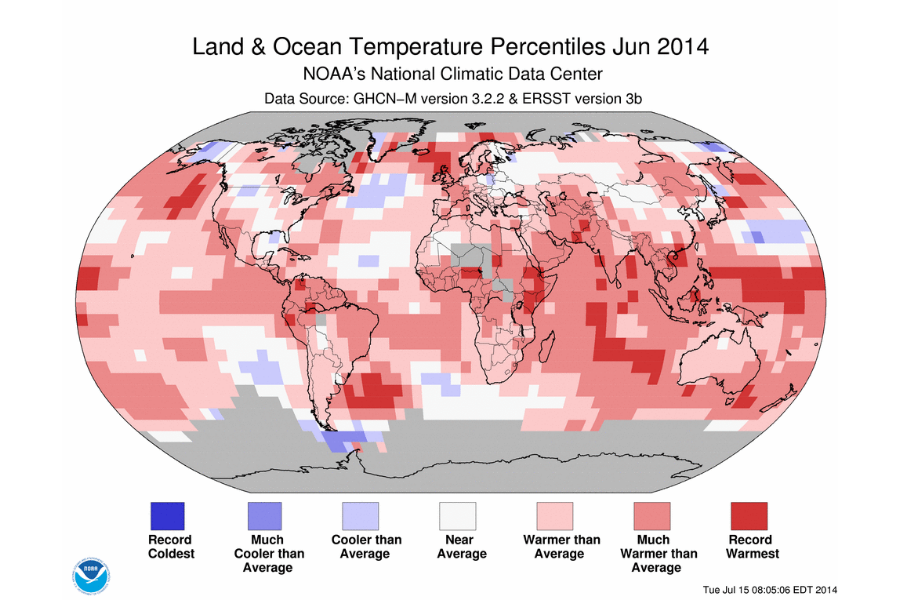Earth's hottest June follows hottest May. The new normal?
Loading...
Things are heating up on planet Earth. Average global temperatures shattered records this June ... for the second month in a row, according to a new report from the National Climactic Data Center.
The NCDC, a division of the National Oceanic and Atmospheric Administration, analyzed data from 2,000 weather stations scattered across the globe measuring both ocean and land temperatures and found that global average temperatures surpassed the previous record by 1.3 degrees Fahrenheit. That makes June 2014 the warmest June since record keeping began in 1880. If this trend continues, 2014 could top 2010 as the warmest year recorded.
Record-breaking temperatures have almost become the new norm, says climate scientist Benjamin Zaitchik, an assistant professor at Johns Hopkins University in Baltimore. The 10 warmest years on record have all occurred since 1998.
"It's never surprising to see a record-high temperature set these days," Professor Zaitchik says. "But when you see 352 months in a row that are warmer than the 20th-century average, it's pretty clear that we are seeing a long-term global warming trend."
Last month was the 38th consecutive June that surpassed 20th-century averages, and global temperatures have not dipped below last century’s average since February 1985.
The June data will hardly surprise residents of California and the Southwest, who have seen their own local record-breaking heat in recent months. California experienced the warmest January through June on record this year, with daily high temperatures sitting nearly 5 degrees above average. Excessive heat has driven more than one-third of California into exceptional drought.
People in other parts of the US may have more trouble reconciling the global averages with their own personal experiences, especially in the mid-South and the Midwest, where wet and cloudy weather kept temperatures below normal.
It is crucial to distinguish between local weather and global climate to understand the seeming discrepancy between what might be happening locally and what’s happening to the planet as a whole, says Jessica Blunden, climate scientist for the NCDC in Asheville, N.C., and author of the NCDC June 2014 Global Report. Climate is the type of weather you expect to have on average over a long period. Weather, however, refers to what happens from day to day and is a result of many factors such as climate, but also atmospheric wind and precipitation patterns.
“What you see on the global scale is not necessarily going to match up with what’s happening where every single person lives,” Ms. Blunden says.
While weather has brought near-record-cool temperatures to parts of Georgia, Alabama, Indiana, Illinois, and Iowa, these are some of the only places of the planet to experience cooler-than-normal temperatures last month. Parts of Greenland, South America, Africa, and Southeast Asia all saw the mercury climb higher than any previous June on record. More than 30 countries on every continent except Antarctica endured record-breaking heat.
A gathering El Niño – a disruption in the Pacific Ocean-atmosphere system that triggers unusually warm temperatures around the globe – has probably contributed to the rising temperatures to some degree, but global climate change is the main underlying cause of the warming trend, Blunden says.
“You are always going to have natural weather events such as El Niño. That’s not going to go away. But what you look at is the underlying trend,” she says.
Temperatures last month surpassed those of every June since 1880, even those that occurred during El Niño years. That underlying trend is evidence that climate change is indeed upon us, she says.
“Releasing less greenhouse gasses into the atmosphere is probably the only thing that can be done to stop the warming,” Blunden says. “That’s what’s driving the long-term warming trend.”
There is a possibility that even the record cold that hit much of the US this past winter may have also been caused by climate change, Blunden says.
“This is still under investigation, but it is possible that climate change is having an impact on the jet stream and is causing the jet stream to form the way it has where we have seen polar vortexes dip further south than usual,” she says.








